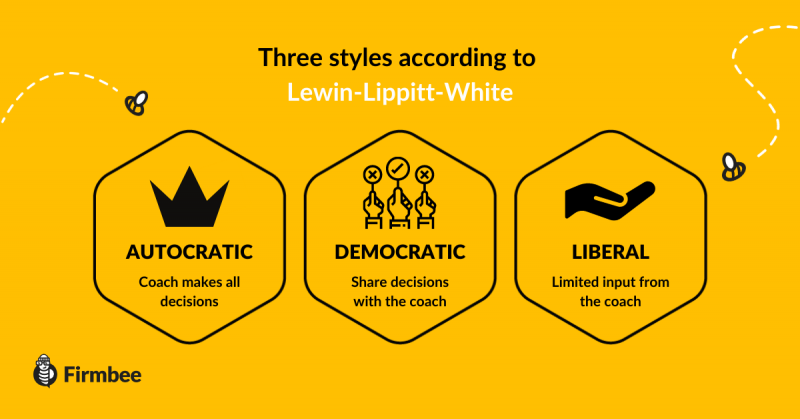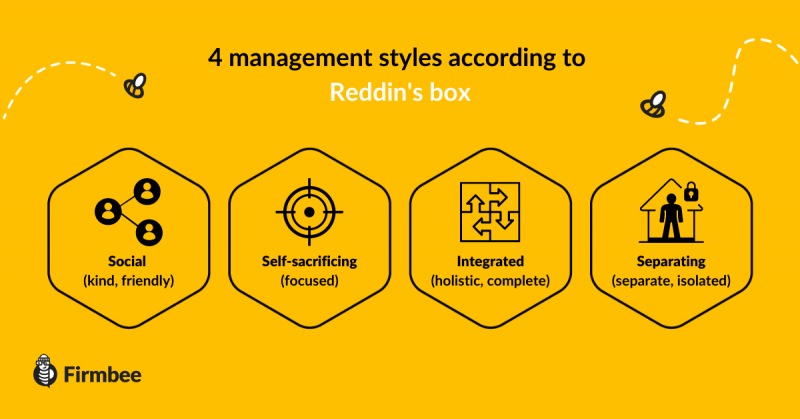People who perform tasks related to managerial functions in a company use methods to supervise people. Management styles vary according to experience, employees’ predispositions, or the company’s characteristics. They are not a fixed value, and as the situation changes, they should be adapted to new conditions. So far, at least a dozen styles of human resources management have been distinguished. Scientists, studying this subject, have also developed many lists of subtypes and managerial models, used in modern companies. We would like to discuss the most prominent ones and suggest which style adapts to what circumstances.
Management styles. Table of contents:
- Management styles in a company – what are they?
- 3 management styles according to Lewin, Lipiitt and White
- 4 management styles according to Reddin’s box
- What management style is the best?
- Contemporary leadership styles. What does it look like at major companies?
Management styles in a company – what are they?
Management style can be defined as a system whose primary goal is to maintain efficient and effective coordination of tasks in the company. A well-managed team is supposed to be motivated to work, effective in their actions and well organized in performing their duties. The overriding aim of management is to achieve goals, and in the context of the company, to earn profits.
Management styles are implemented to increase the efficiency of the use of resources in the company and to attain desired goals faster. Depending on the specific scientific approach, different management styles emphasize different aspects of management techniques. The evaluation of their effectiveness also differs, so that in some cases one style may fail, while in other circumstances it will prove effective.
3 management styles according to Lewin, Lipitt and White
They are based on the aspect of task execution by the manager. Therefore, they are nothing else than a specification of the nature of managerial activities in the company.
Researchers have distinguished three basic styles of management, which became the basis for the development of new management techniques, adapted to today’s realities. Thus, Lewin, Lipitt and White’s conclusions concern the delineation of three basic groups of managerial characteristics.
These are the following management styles:

1. Democratic style
The manager sets the framework for the execution of the project; however, it will be up to the employees themselves to determine the method and technique of accomplishing the goal. The workforce also decides how to assign particular tasks to particular people.
The manager-democrat does not interfere in the work of the team unless necessary. It is a style of management based on considerable trust and a lot of voluntariness in work.
2. Liberal style (non-interfering)
The manager does not participate in the work of the team, leaves full flexibility to employees on how to perform given tasks. The manager-liberal does not interfere during the process of implementation of activities, gets involved only at the end, giving notes to individual employees.
This is a style in which the manager consciously gives up participation and closeness to the team.
3. Autocratic style
The manager personally assigns specific tasks to individual staff members. He also determines how to perform work, with what techniques, and to what extent employees know the overall purpose of the work.
It often happens that employees performing tasks in this style of management do not get to know the global objectives of the team – they focus only on performing personalized, individually assigned tasks.
4 management styles according to Reddin’s box
J.W. Reddin developed the classic theory of Blacke and Mouton, distinguishing a new classification of management styles. He referred to his creation as a box, in which the author used three dimensions: tasks, people and effectiveness of the implementation of managerial tasks.
In Reddin’s classification, there are 4 management styles, placed in the center of the box. They refer to the core values and are not focused on the effectiveness of executing the duties of the staff. Each of these styles has a counterpart with lower or higher effectiveness.
Here are the management styles in the Reddin box:

1. Social (kind, friendly)
This is a liberal style that focuses on the human aspects rather than accomplishing tasks “at all costs.” A manager following Reddin’s sociable style is characterized by openness to employees, building rapport with the workforce, and the ability to prevent crises.
2. Self-sacrificing (focused, zealous)
An autocratic style that focuses on bossy methods of managing employees. The manager is guided by the principle of suitability, according to which he or she assigns people to perform specific tasks.
3. Integrated (holistic, complete)
It is an approach that has the characteristics of a pragmatic style, being both employee-oriented and task-oriented. The manager uses group advice, but makes decisions independently and based on the principle of suitability.
4. Separating (separate, isolated)
A passive style that is distinguished by a little emphasis on people and tasks. The manager is characterized by a rational approach and is not focused on direct contact with a group of employees.
What management style is the best?
It is impossible to isolate one universally best management style. It is good practice to use different styles depending on the situation.
Fresh entrepreneurs should initially use authoritarian leadership styles due to the small number of employees in the first phase of the company’s existence. Over time, the autocratic style alters itself into a democratic style due to the intensive growth of the company, building a permanent structure, and expanding the workforce.
The autocratic style requires an unyielding personality of the manager, so in some situations, it is difficult to implement. In most cases, a good solution is to apply a democratic or liberal style of leadership – the manager then becomes a facilitator, a person supervising, rather than an executor involved directly in the work of the team.
Contemporary leadership styles. What does it look like at major companies like Google?
Laszlo Bock, a prominent Google activist, once responsible for the human resources department of the American corporation, in his publication presented the characteristics of the management style, which brought great success to Google.
It turns out that the appropriate arrangement of office space style, or organizing special recreational areas for employees is not enough. According to the author, it is necessary to abandon “hierarchical thinking”, in favor of “more freedom for employees”.
Bock’s approach is extremely liberal. It advises supervisors not to punish or reward employees. Modern management strategy according to Google is also focusing on values, morality, the ability to articulate views by each employee.
The global brand Microsoft, on the other hand, emphasizes “positive management” aspects when it comes to leadership styles. Satya Nadella, CEO of Microsoft, presented three pillars on which the author’s style of management was created in the company. These are transparency, energy and unconditional success.
Want to stay in touch with our content? Join our Facebook community
Author: Andy Nichols
A problem solver with 5 different degrees and endless reserves of motivation. This makes him a perfect Business Owner & Manager. When searching for employees and partners, openness and curiosity of the world are qualities he values the most.
The most important questions
-
What are the basic styles of management?
Depending on the division, there are 3 or 4 management styles. A simplified division includes the democratic style, authoritarian style and liberal style.
-
Which management style is currently fashionable?
Increasingly, there is a move away from rule by a firm hand in favor of giving more freedom to employees. Examples of companies implementing modern liberal management styles include major American corporations.
-
How do I know when to use a particular management style?
The implementation of a management style depends, among other things, on the manager’s managerial skills, the experience of the staff, or the characteristics of the company. In many cases, the selection of the appropriate style is based on the trial and error method. What is important, particular styles can be modified and changed depending on needs.














